This blog is dedicated to a magical place called Sapelo Island, Georgia. It's one of the Georgia Sea Islands. Because of the Georgia Sea Island Singers, I had heard about them long before I actually visited. They are renowned for having kept much of their African heritage intact. Reading up beforehand, Sapelo seemed like the only one of the islands as yet unspoiled by tourism. Cornelia Bailey's wonderful first-hand account, God, Dr. Buzzard, and the Bolito Man (2000) sold me on the place.. In fact when it came time to reserve a place to stay, Cornelia was the first and only person I called (her place is on the internet). It took a couple of times before I connected. "Grandma's at church," a young voice informed me the first time. She turned out to be the epitomy of informality and accommodation.
Sapelo, after the Indians died off from European diseases, was originally slave plantations growing rice. They imported slaves from a particular part of West Africa where the inhabitants had already been growing rice in similar soil for centuries. The most knowledgable slaves showed their owners how to do it. Later the plantations switched to the more profitable crops of sugar and cotton.
In the Civil War, the slaveowners fled inland, taking their slaves with them. The US Navy bought supplies from the few who remained. After the War, when Congress granted former slaves the right to "40 acres and a mule" from the old plantations, many returned, along with others who saw the island as a place to farm. When Congress changed its mind and wanted money for the land, most former slaves became share-croppers on the new plantations. Some, sooner or later, were able to buy their land, and settled mostly on the northern end. In the 1930's, tobacco king R.J. Reynolds took over, although still growing the existing crops, not tobacco. He hired the farmers to work for him on the southern end, and induced them to trade their parcels for homesites near his fields, where there was access to electricity and indoor plumbing. When he died, his widow sold his land, essentialy the whole island except 434 acres, to the State of Georgia, which still owns it as a wildlife reserve and field station.. The descendents of the slaves either left, continued to do odd jobs, or eked out a living on their small plots.. Some returned to retire. About 50 souls live there now, protected from development by the state's ownership of the land and the lack of any connection by road or auto ferry to the mainland. It's the last of a vanishing way of life.
Thursday, April 26, 2007
Chapter One: The Morning Bus Tour
It was late February, cold and wet at home in Oregon, but a pleasatly warm spring in Georgia. Unable to pull ourselves away from Savannah in time, we didn't come close to catching the evening passenger ferry to Sapelo. As my wife drove south on I-95, I called Cornelia, and she said, sure, tomorrow was fine, too. I also changed our ferry reservation. After dark, we pulled off at the Crescent/Townsend exit and booked into one of the two $35 a night motels there. We had dinner at a pleasant restaurant on the Sapelo River. The next morning we caught the 8:30 ferry.
When you get to the island, the first thing you notice is that most of the cars parked at the dock don't have license plates.

Dolores, who led the morning bus tour, explained why. "Nobody wants to bother with us. When there's an accident, the insurance company won't pay even if somebody broad-sided you. That happened to the bus, which the State of Georgia had insured. There's no stop-signs, and no proper street signs, they say. So nobody bothers to get insurance. Or even register their cars. You need all that once you're off the island, but here, hey, there's not even any gas stations or car repair shops. We make do ourselves."
I wondered how the cars got on the island in the first place, since they obviously wouldn't fit on the passenger ferry. "There's a barge for our use," Dolores explained. "And if there's a medical emergency, a helicopter flies in," she said, anticipating our next question.
Dolores drove as well as entertaining us with stories. The first road was called the "North-South Autobahn." Well, isn't that a road sign? It was paved in parts. The old bus took us to our first stop, Behavior Cemetery.
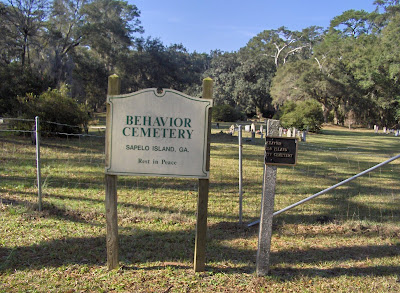
I wondered: Is this where you ended up if your owner thought you had a behavior problem? In a manner of speaking, yes. It was named for an old settlement here. Slaves who escaped from the fields hid in the woods. They were the "behavior" slaves.
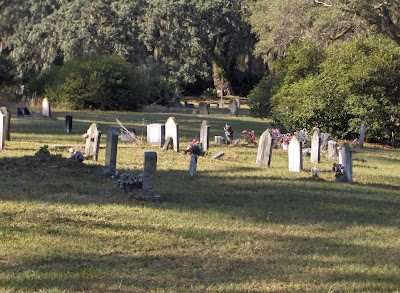
Our next stop was the field station of the University of Georgia, which studied the ecology of the marshland here. A sign explained the different types of land.
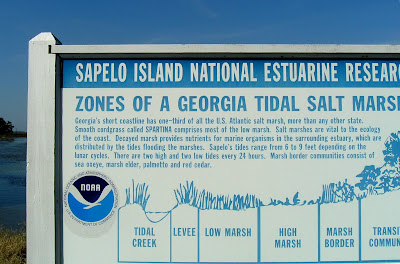
At the visitor center, where we stopped after returning to the mainland, there was a map with the different types in different colors. This shows you where the different types were. The red means high ground. The green denotes tide flats. The yellow is what interested me, beaches.
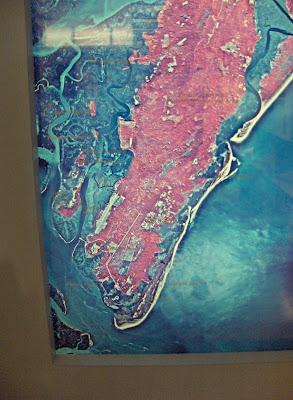
The field station is what is left of the old sugar plantation.

A few walls remain from the beginning.
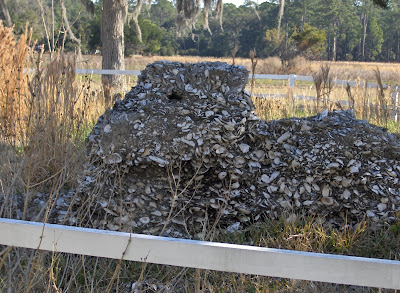
They're made of "tabby," which is a mixture of sand, water, oyster shells, and lime. It was pretty durable stuff.
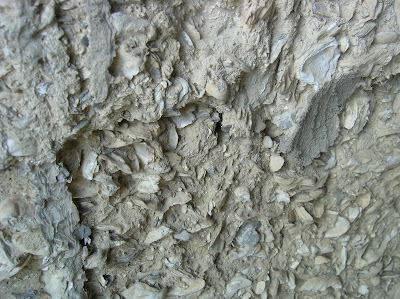
Later owners built wooden living quarters for the slaves and, later, field workers. These became the living quarters and laboratories of the field station.
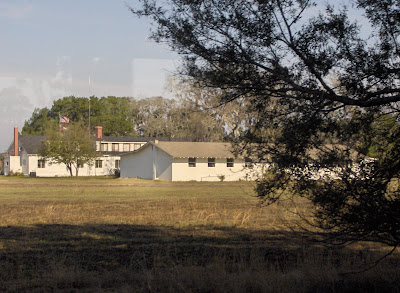
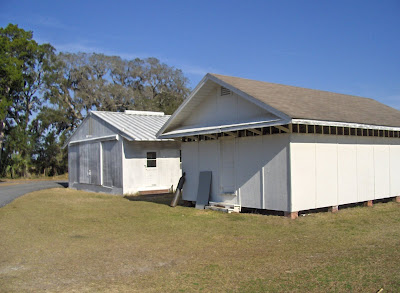
On the field station's dock, Dolores demonstrated for us how they catch fish in these marshes, using a met. You have to arrange it first, so it won't tangle up when you throw it out.
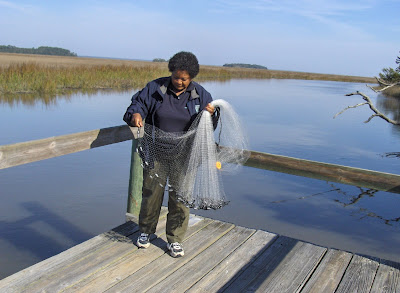
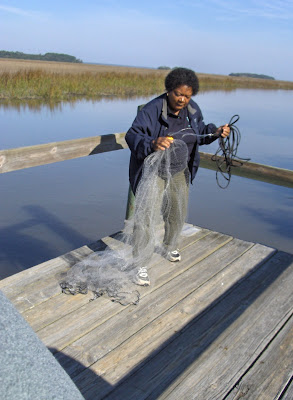
Then if all goes well, the net casts over a pretty wide swath of water. It helps to have grown up doing this, like Delores.

We board the bus again for our next stop.

When you get to the island, the first thing you notice is that most of the cars parked at the dock don't have license plates.
Dolores, who led the morning bus tour, explained why. "Nobody wants to bother with us. When there's an accident, the insurance company won't pay even if somebody broad-sided you. That happened to the bus, which the State of Georgia had insured. There's no stop-signs, and no proper street signs, they say. So nobody bothers to get insurance. Or even register their cars. You need all that once you're off the island, but here, hey, there's not even any gas stations or car repair shops. We make do ourselves."
I wondered how the cars got on the island in the first place, since they obviously wouldn't fit on the passenger ferry. "There's a barge for our use," Dolores explained. "And if there's a medical emergency, a helicopter flies in," she said, anticipating our next question.
Dolores drove as well as entertaining us with stories. The first road was called the "North-South Autobahn." Well, isn't that a road sign? It was paved in parts. The old bus took us to our first stop, Behavior Cemetery.
I wondered: Is this where you ended up if your owner thought you had a behavior problem? In a manner of speaking, yes. It was named for an old settlement here. Slaves who escaped from the fields hid in the woods. They were the "behavior" slaves.

Our next stop was the field station of the University of Georgia, which studied the ecology of the marshland here. A sign explained the different types of land.

At the visitor center, where we stopped after returning to the mainland, there was a map with the different types in different colors. This shows you where the different types were. The red means high ground. The green denotes tide flats. The yellow is what interested me, beaches.
The field station is what is left of the old sugar plantation.

A few walls remain from the beginning.

They're made of "tabby," which is a mixture of sand, water, oyster shells, and lime. It was pretty durable stuff.

Later owners built wooden living quarters for the slaves and, later, field workers. These became the living quarters and laboratories of the field station.


On the field station's dock, Dolores demonstrated for us how they catch fish in these marshes, using a met. You have to arrange it first, so it won't tangle up when you throw it out.


Then if all goes well, the net casts over a pretty wide swath of water. It helps to have grown up doing this, like Delores.

We board the bus again for our next stop.

Chapter Two: At the Reynolds Mansion

Our next stop on the tour is the R. J. Reynolds mansion, starting with its empty pool and fountain. It was built in the 20s, and numerous celebrities came as the tobacco magnate's guests throughout the 30's, 40's, and 50's. Charles Lindburgh is said to have flown in, landing on the nearby beach. Today it can be rented for a fee, and various groups make it their base while enjoying the island. A few are sitting around reading as we tour.
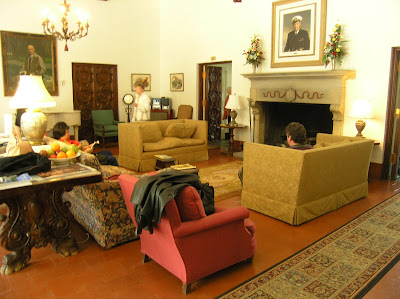
Here is the dining room.
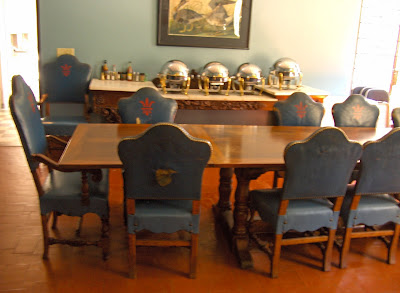
The elegant woodwork, stained glass, and drawing room show off Reynolds' good taste.
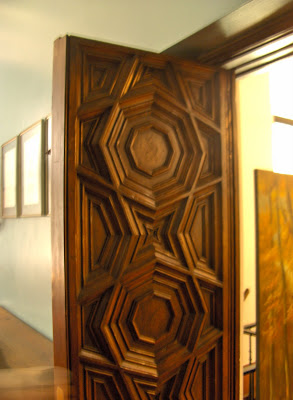
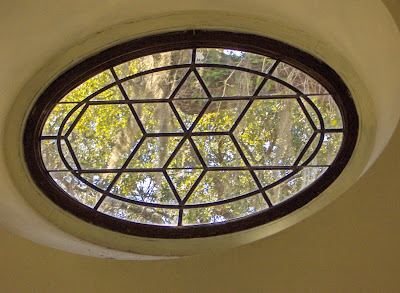

There is also a basement, dedicated mostly to sport.
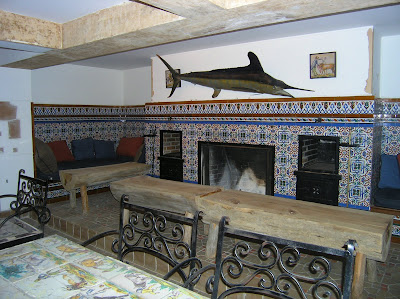
A bar suggestive of a ship.

On the wall is a fanciful portrait of William Keach, the infamous "Blackbeard the pirate," who used a small island next to Sapelo's northern end as a base in the 1700's.
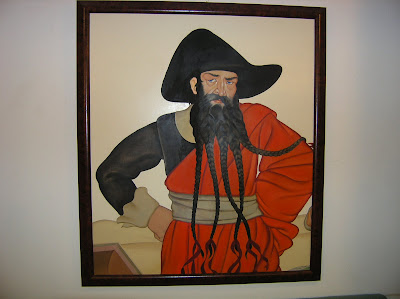
The gun room, with ammunition boxes aong the wall.

Even a bowling alley.
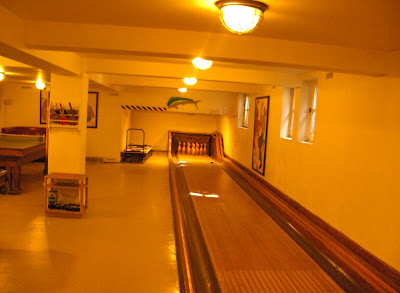
Near the mansion is the lighthouse, built around the turn of the century.
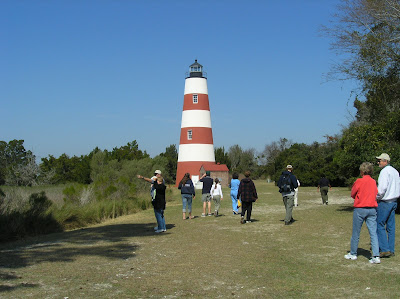
It is set amidst salt flats teaming with wildlife.
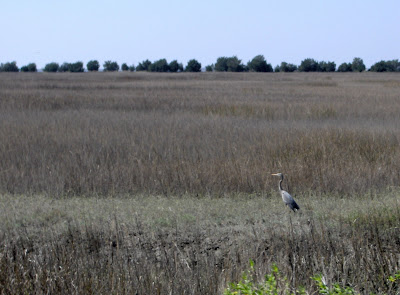
The view from the top of the lighthouse:
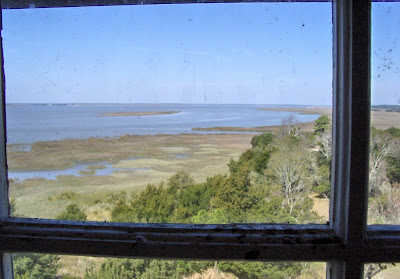
On the drive out, Dolores told us about the "turkey monument" that we passed by, out by the barns. It seems that R. J. had it built as a surprise for his wife. He kept it covered until it was done, and then brought her over and unveiled it proudly.
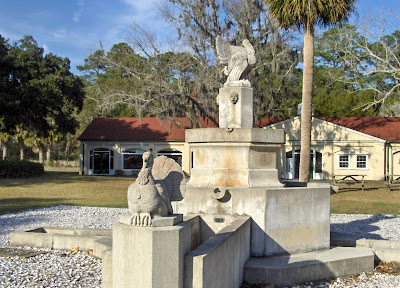

The wife reportedly was not amused. One day, when R. J. was having one of his emphysema attacks, his oxygen mask was missing. They found it in time, in a laundry bin with dirty laundry. A heavy smoker, he died at age 55, from lung cancer. Poetic justice. Of course his death was not attributed to the cigarettes he made his money from.
And so we returned to the dock, where Cornelia was waiting to drive us to our new digs.

Chapter Three: Hog Hammock

We drove up the North-South Autobahn and turned right, onto a gravel road. A sign told us we were entering historic Hog Hammock. I had an image of a fat pig in a hammock, but Cornelia said "Hog" was the name of the family that settled here first, and "Hammock" is the word for a piece of high ground firm and dry enough for trees.
And the population was more like 50 these days. A few people died.
The Bailey property consists of the family's house in blue, the guesthouse in brown, and the lawn plus gazebo:
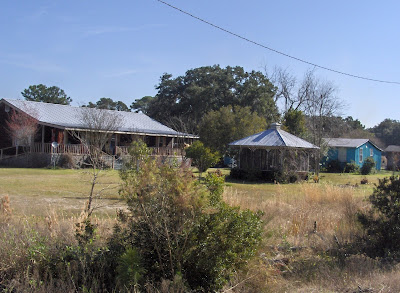
Next door was a gift shop, open whenever a tour bus stopped. It shared a small building with a bar, called "The Trough." It closed pretty early, and opened late. I never saw any customers. The guesthouse next door, where we stayed, was "The Wallow." From the sense of humor, I would wonder whether the same people owned all three.

Inside "The Wallow" were six bedrooms, on either side of a long hall, plus a common area. Here is a shot of one of the bedrooms. I apologize for the flash. For what we reserved, we paid $60 a night. We were the only ones there both nights.
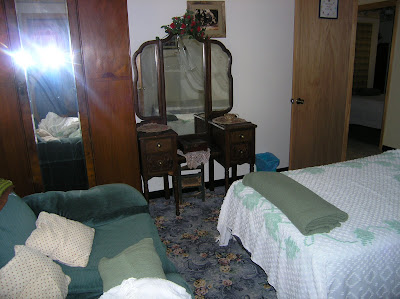
The common area had a long dining room set up for at least 10 people.
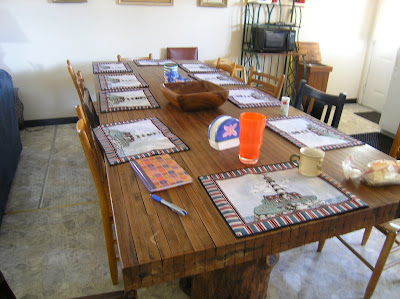
The kitchen area had a stove, fridge, microwave, sink, and countertops. Cornelia said we could help ourselves in the fridge. There were fresh eggs and a seed cake she had just baked (in tinfoil here), along with various things left by former guests. I will tell you about the pecans later. She brought over the prickly pears after she met us. She said they were good for the prostate. Then there were various herbs from the island.

The common area had a piano on one side.
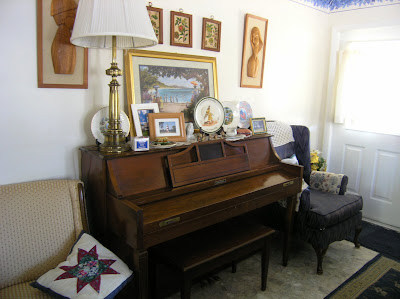
And various framed articles about the place were on various walls.

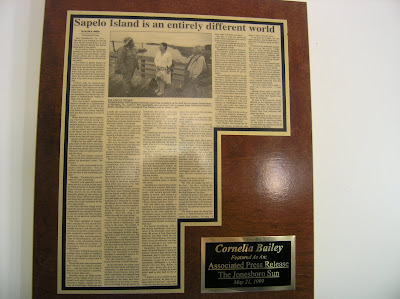
Sitting in the gazebo that afternoon, J.J., Cornelia's grandson, came over and entertained us with conversations on his toy cell phone.
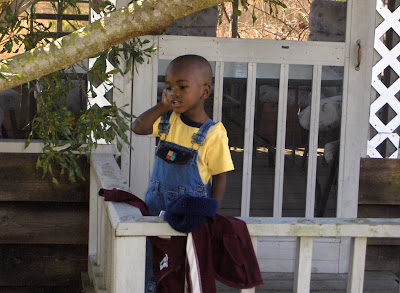
The next morning we got a chance to visit with Cornelia herself. Here she is with me.

And now she's thinking of what to write in our copy of her book. (Actually, it is my local library's. I'm going to have to either return it or replace it one of these days.)
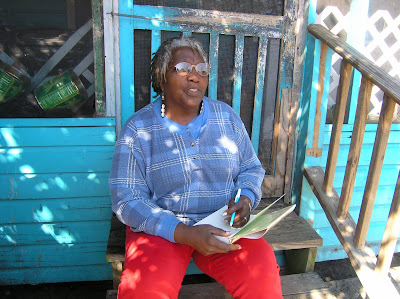
As it happened, we didn't do much cooking. One day, we ate at the Senior Center and met a few of the old-timers.
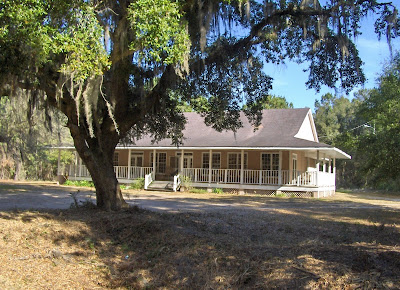
Another day we ate at a breakfast and lunch place nearby. They served up very tasty pork chops, fish, or chicken, with potatoes and greens. (I don't have a photo.) We saved what we couldn't eat and had it for dinner. There's no place to buy groceries on the island. B.J.'s Confectionary (below) used to sell them, but it's closed permanently now, according to Cornelia.
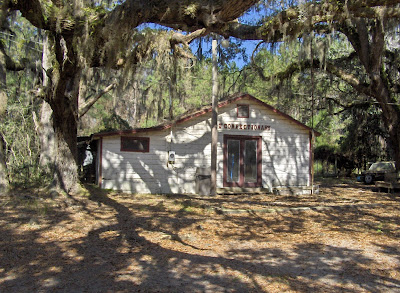
The old homes or cabins around town fit my image of swamp living precisely.



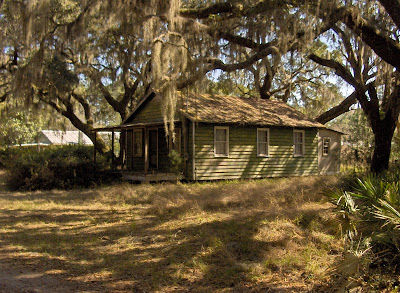
Down the street from Cornelia's is St. Luke's Baptist. A preacher comes once a month, on the 2nd Sunday. It's the only church with regular services. One other is used on special occasions. We'll see it later.

Another institution in Hog Hammock, which Cornelia helped to found, is the Sapelo Island Cultural and Revitalization Society. It does what it can to keep Sapelo from homogenizing into American society, as has happened to every other sea island in Georgia and South Caroline.

It is not entirely successful. Witness the new construction near Cornelia's, the first encroachment by whites in this traditional African-American enclave. "Somebody off-island inherited the land and sold it," Cornelia said. She'd like to get some zoning with teeth in it. But not many property owners live here any more.

Somehow the new architecture, done to current building codes, does not blend in with the old.

Subscribe to:
Posts (Atom)